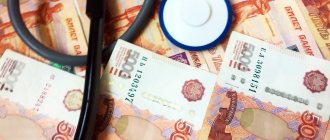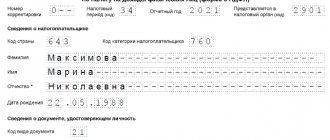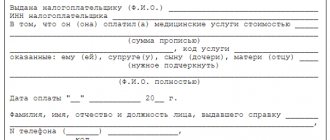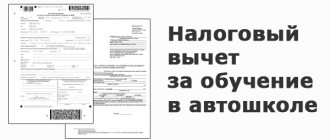The legislation of the Russian Federation in the field of taxation provides, in some cases, for the refund of taxes withheld from wages. If an individual is building an apartment, paying for children’s education or undergoing treatment in the Russian Federation. In case of expensive treatment, the list for 3 personal income taxes is on the website of the Federal Tax Service. We will tell you which treatments are expensive and who is entitled to such a tax deduction.
Special deduction
When filling out 3-NDFL, which relates to expensive treatment, it is of great importance. The fact is that on the basis of one of the paragraphs sub. 3 p. 1 art. 219 of the Tax Code of the Russian Federation, the amount of deduction for such medical services is not limited by law.
Thus, the patient has the right to declare the amount of expensive treatment in 3-NDFL that he spent on relevant medical procedures.
An important point: you can claim a deduction in 3-NDFL for expensive treatment when undergoing it not only in specialized organizations, but also from entrepreneurs who officially conduct medical practice.
Also see “Social deductions for personal income tax in 2016: what you can count on.”
Declaration
It makes sense to start filling out 3-NDFL for expensive treatment only if you have a special certificate from a medical institution with a special note (approved by order of the Ministry of Health of the Russian Federation No. 289, Ministry of Taxes of the Russian Federation No. BG-3-04/256 dated July 25, 2001):
In this help, pay attention to the service code field. There is a reason to declare expensive treatment in 3-personal income tax only when the value is “2”. If “1”, then the right to deduct for treatment is limited to the standard amount of 120,000 rubles.
Depending on what code is in this certificate, you will understand whether ordinary treatment or expensive treatment can be declared in 3-NDFL. That is, the actual amount you paid does not matter.
Indicating expensive treatment in the 3-NDFL declaration is quite simple. Line 110 of Sheet E1 is intended for this purpose (see figure below). There are no special rules for filling it out. Therefore, obtaining a sample of 3-NDFL for expensive treatment usually does not cause difficulties.
Also see “How to fill out 3-NDFL for treatment for 2016.”
Personal income tax deduction for expensive treatment
Any employee can be provided with a personal income tax deduction. A tax deduction is a fixed amount of money that reduces an employee’s income when calculating tax. Deductions can be standard, social, property, professional, or investment. The tax deduction for treatment is a social deduction.
Social tax deductions are regulated by Article 219 of the Tax Code of the Russian Federation and are also provided upon submission of an application and relevant supporting documents. But there is also a difference from standard deductions: to receive social deductions, you must fill out and submit a tax return, Form 3-NDFL.
Documents for receiving a deduction
The Federal Tax Service of Russia, in a letter dated 09/03/2019 No. BS-3-11/ [email protected], informed about the conditions for obtaining a personal income tax deduction for treatment, including expensive ones, as well as about the documents that need to be submitted to receive the deduction.
To provide a tax deduction, the taxpayer must collect the necessary package of documents.
To do this, you need to submit a written application to the tax office for a tax deduction and attach documents confirming the expenses incurred.
To receive a tax deduction for treatment, you need to obtain from a medical institution:
- agreement with a medical institution. If it does not contain license details, you must obtain a separately certified copy of the license;
- certificate of payment for medical services. The original is submitted to the tax office. From this certificate you can see what kind of treatment was - ordinary or expensive. If the service code is 1, then the treatment is inexpensive (limited to a limit of 120,000 rubles), if 2, then it is expensive;
- if there are documents confirming payment for treatment, they can also be submitted to the inspection to avoid additional questions from the inspector;
- When returning money spent on medicines, you will need the original doctor's prescription. In this case, payment documents confirming their purchase will be required.
In the commented letter, tax officials draw attention to the fact that one of the main documents is a certificate of payment for medical services.
The certificate must be completed by all healthcare institutions licensed to carry out medical activities, regardless of departmental subordination and form of ownership. It certifies the fact of receiving a medical service and paying for it through the institution’s cash desk at the expense of the taxpayer. It is in the certificate that it is indicated whether the service provided relates to expensive treatment (code 2) or not (code 1).
Please note: an employee can receive social deductions both from the tax office where he is registered when filing an income tax return for the past year, and from the employer.
If an employee receives a notice from the tax office confirming the right to receive a deduction, he can receive a deduction from the employer before the end of the tax period.
The application to the employer is filled out in any form, where they provide a link to the number of the notification of the right to deduction received from the tax office.
As for the deduction for treatment, the deduction for treatment is provided in the amount of actual costs, but is limited to a total amount of 120,000 rubles for the tax period. You can return 13% of the amount of expenses within 120,000 rubles, that is, no more than 15,600 rubles. (RUB 120,000 × 13%).
In addition, the amount of such deductions cannot exceed the amount of personal income tax paid by the taxpayer for the year.
Example 1. How to calculate deductions for treatment
Kornilov P.F. in 2022, he spent 120,000 rubles on his treatment. Amount of tax to be reimbursed: RUB 15,600. (RUB 120,000 × 13%). For the year, Kornilov paid 12,000 rubles from his income, subject to personal income tax at a rate of 13%. He will be able to return only 12,000 rubles from the budget.
Some nuances of deductions for treatment
Taxable income can be reduced by expenses spent on treatment in Russian medical institutions for individual entrepreneurs providing medical services. A deduction for treatment can be obtained if the treatment was carried out by privately practicing doctors who have a license. Treatment deductions are also provided in the amount of the cost of medicines for medical use.
It is important to note that for expensive types of treatment in medical institutions in Russia and expensive medications, the amount of tax deduction is accepted in the amount of actual expenses incurred, that is, it is not subject to the limit of 120,000 rubles.
Let's look at an example of the difference between deductions for routine treatment (medicines) and deductions for expensive treatment (expensive drugs).
Example 2. Limitation of deductions for treatment
Davydov S.V. in 2022, he paid for expensive treatment (surgery to restore vision) in the amount of 200,000 rubles and spent 90,000 rubles on regular treatment. Davydov can receive a deduction for expensive treatment in full in the amount of 26,000 rubles. (RUB 200,000 × 13%). Expenses for routine treatment are limited to 120,000 rubles, but the deduction for such treatment is limited to the amount of personal income tax paid for the year. For the year, the amount of personal income tax paid by him is 35,100 rubles. Therefore, only the amount of 9,100 rubles can be returned from the budget. (35,100 – 26,000).
The cost of paid for expensive medical consumables is taken into account when providing a tax deduction for expensive types of treatment, if the medical organization itself does not have such materials. It does not matter under what conditions (paid or free) the medical organization provided these services. Tax authorities remind us of this, referring to the letter of the Federal Tax Service of Russia dated August 31, 2006 No. SAE-6-04 / [email protected]
The tax authority has the right to provide the taxpayer with a deduction in the amount spent on the purchase of medical materials, subject to confirmation of the fact of their use in carrying out expensive types of treatment.
To confirm your right to receive a tax deduction for expenses on the purchase of medical consumables, you must submit the following documents to the inspectorate:
- Certificate of payment for medical services indicating code 2. If the taxpayer is provided with expensive treatment services free of charge, in the Certificate of payment for medical services the cost of medical services provided may be indicated in the amount of 0 rubles;
- discharge summary, which will confirm the prescription of appropriate medical consumables by the attending physician and their use during expensive treatment;
- copies of payment documents for the purchase of the specified medical consumables.
Treatment deductions are also provided in the amount of the cost of medications prescribed by the attending physician. Until 2022, a deduction could be obtained when purchasing only those drugs that were included in the list approved by Decree of the Government of the Russian Federation dated March 19, 2001 No. 201.
From 2022, you no longer need to check the list. Social deductions are now provided to all personal income tax payers who spent money on purchasing drugs according to a doctor’s prescription (clause 2, article 1, part 5, article 2 of Federal Law No. 147-FZ of June 17, 2019). Therefore, you can already claim a deduction for the cost of prescription drugs purchased in 2022.
Scroll
For 2022, what relates to expensive treatment in 3-NDFL is listed in Decree of the Government of the Russian Federation of March 19, 2001 No. 201. Here is the complete list:
| № | Type of treatment |
| 1 | Surgical treatment of congenital anomalies (developmental defects) |
| 2 | Surgical treatment of severe forms of diseases of the circulatory system, including operations using artificial circulation machines, laser technologies and coronary angiography |
| 3 | Surgical treatment of severe forms of respiratory diseases |
| 4 | Surgical treatment of severe forms of diseases and combined pathologies of the eye and its adnexa, including the use of endolaser technologies |
| 5 | Surgical treatment of severe forms of nervous system diseases, including microneurosurgical and endovasal interventions |
| 6 | Surgical treatment of complicated forms of digestive diseases |
| 7 | Endoprosthetics and reconstructive operations on joints |
| 8 | Transplantation of organs (complex of organs), tissues and bone marrow |
| 9 | Replantation, implantation of prostheses, metal structures, pacemakers and electrodes |
| 10 | Reconstructive, plastic and reconstructive plastic surgeries |
| 11 | Therapeutic treatment of chromosomal disorders and hereditary diseases |
| 12 | Therapeutic treatment of malignant neoplasms of the thyroid gland and other endocrine glands, including the use of proton therapy |
| 13 | Therapeutic treatment of acute inflammatory polyneuropathies and complications of myasthenia gravis |
| 14 | Therapeutic treatment of systemic connective tissue lesions |
| 15 | Therapeutic treatment of severe forms of diseases of the circulatory, respiratory and digestive organs in children |
| 16 | Combined treatment of pancreatic diseases |
| 17 | Combined treatment of malignant neoplasms |
| 18 | Combined treatment of hereditary bleeding disorders and aplastic anemia |
| 19 | Combined treatment of osteomyelitis |
| 20 | Combined treatment of conditions associated with complicated pregnancy, childbirth and the postpartum period |
| 21 | Combined treatment of complicated forms of diabetes mellitus |
| 22 | Combined treatment of hereditary diseases |
| 23 | Combined treatment of severe forms of diseases and combined pathologies of the eye and its adnexa |
| 24 | Complex treatment of burns with a body surface area of 30 percent or more |
| 25 | Types of treatment associated with the use of hemo- and peritoneal dialysis |
| 26 | Nursing premature babies weighing up to 1.5 kg |
| 27 | Treatment of infertility using in vitro fertilization, cultivation and intrauterine embryo insertion |
Note that this list has not undergone major changes over the past more than 10 years. Therefore, there is little hope for the emergence of new positions in it.
What about dentistry?
One of the most popular questions is whether dentistry is included in the list of expensive treatments for 3-NDFL? It turns out yes. Namely, ONLY the operation of implanting dentures.
Other dental prosthetics (so-called orthopedic dentistry) have a code. That is, the upper deduction limit is 120,000 rubles along with other social deductions during the tax period.
These conclusions are confirmed by letters from the Ministry of Health and Social Development of Russia dated November 7, 2006 No. 26949/MZ-14 and dated November 8, 2011 No. 26-3/378332-2065.
Results
The taxpayer has the right, in relation to the personal income tax withheld from his income, to take advantage of a social deduction in the amount of expenses spent on treatment (for himself or for family members). In particular, he may bear the costs of purchasing medications. Until 2022, deductions are possible only for medications according to the list from the Decree of the Government of the Russian Federation dated March 19, 2001 No. 201. For deductions for 2022, this restriction has been removed. There are certain requirements for documents confirming that a doctor has prescribed this particular medicine.
To receive a deduction with all the documents confirming your right to it, you need to contact the Federal Tax Service either in the year of treatment expenses (then the deduction can be taken into account at the place of work), or at the end of this year (then the Federal Tax Service will return the tax). In the latter case, along with documents confirming the right to deduction, you will also have to submit a declaration in form 3-NDFL and certificates in form 2-NDFL confirming the amount of tax withheld for the year.
Sources: Decree of the Government of the Russian Federation dated March 19, 2001 N 201
You can find more complete information on the topic in ConsultantPlus. Free trial access to the system for 2 days.









